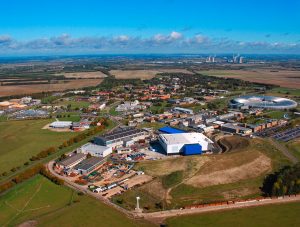BAA One Day Autumn Meeting 2024 – Current Research Highlights
Saturday 21st Sep 2024 10am to 5:30pm
The BAA One Day Autumn Meeting will be held on the topic of Current Research Highlights at the Rutherford Appleton Laboratory on the Harwell Campus, Didcot, OX11 0QX in conjunction with RAL Space and Newbury Astronomical Society.
Ticket prices
Adults = £12 or £9 with the BAA member discount
Under 16 = £9 or £6.75 with the BAA member discount
Follow this link to book your tickets (closes Friday 13th September at 8am): https://buytickets.at/baa/1288347
Programme – Abstracts below
| 09:00 | Arrival, Registration and Refreshments |
| 10:00 | Welcome to RAL and Health & Safety briefing – Sophy Palmer |
| 10:10 | Welcome on behalf of the BAA – David Arditti |
| 10.20 | Welcome on behalf of Newbury Astronomical Society – Paul Gibson |
| 10.30 | Extreme flares from supermassive black holes Dr Philip Wiseman (Southampton University) |
| 11.30 | The Square Kilometre Array: Big Data and Transformational Science Dr Chris Pearson (RAL Space) |
| 12.30 | Lunch in the RAL Restaurant |
| 14.00 | The ATLAS sky survey and its Virtual Research Assistant Dr Heloise Stevance (Oxford University) |
| 15.00 | Neutron stars and their environments Dr Bettina Posselt (Oxford University) |
| 16.00 | Refreshments |
| 16.30 | The Solar System’s Outer Planets from JWST Dr Michael T. Roman (School of Physics and Astronomy, University of Leicester) |
| 17:30 | Close |
(Programme updated 13/09/2024)
Information on how to get to RAL can be found here:

Abstracts
Extreme flares from supermassive black holes – Dr Philip Wiseman (Southampton University)
Recent observations have discovered a number extremely luminous flares occurring in the centres of galaxies. In this talk I will summarise the observed and inferred properties of the most energetic of all, known as AT2021lwx, which shows a single, smooth, slow optical brightening to a luminosity far greater than any known exploding star (supernova). The luminosity and timescale indicate that a large supermassive black hole is likely the central engine, but how the energy is released, and from what, remains a mystery to which I will discuss the possible solutions. I will also present ongoing work to observe and analyse a sample of similar events, and discuss how they may be crucial processes in the growth of black holes and the shaping of galaxies.
Neutron stars and their environments – Dr Bettina Posselt (Oxford University)
Born in violent supernovae, neutron stars have exceptional properties. The densities in their cores are larger than in an atomic nucleus. Neutron stars are also the strongest and fastest spinning magnets in the Universe. Through their powerful winds and electromagnetic radiation, they interact with their environments. Observationally most notable are pulsar wind nebulae, where the pulsar wind interacts with the interstellar medium or the supernova remnant. However, the environment can also include planets, asteroid belts, discs, and other stars.
What do we know about different neutron star populations and their surroundings? What are the current pressing questions in neutron star research? What can we learn from studying the environments of these compact objects? These will be topics in my talk about the fascinating and often puzzling findings when we observe neutron stars.
The ATLAS sky survey and its Virtual Research Assistant – Dr Heloise Stevance (Oxford University)
Modern sky surveys like ATLAS are capable of imaging the whole visible sky every night. This has brought a deluge of new transient alerts and led the field of transient astronomy to start the shift from an alert limited science to a resource limited one. The human time required to eyeball alerts is very significant and to handle this amount of data sky surveys have been developing machine learning methods to help automate that process. In this talk I will summarise the efforts, breakthroughs and limitations of machine learning methods that have been developed to this end, I will present the direction we have taken at ATLAS with the development of my Virtual Research Assistant, and I want to start a discussion on how extra galactic explosion hunters can best disseminate to a wider community the alerts in our own galaxy which they currently don’t follow up.
The Solar System’s Outer Planets from JWST – Dr Michael T. Roman (School of Physics and Astronomy, University of Leicester)
Despite a century of mid-infrared observations of our Solar System, many mysteries regarding the outer planets remain, in part owing to the challenges of such observations. The cold temperatures and small angular sizes of targets in the outer-Solar System have limited our ability to accurately measure the infrared emission and spectroscopic signatures indicative of their compositions and structures. However, the new James Webb Space Telescope (JWST) has offered planetary scientists a new look at the outer Solar System with a sensitivity never possible before. In this talk, I will review highlights of JWST’s recent observations of the outer Solar System. In particular, I will focus on the outermost giant planets, Uranus and Neptune, whose mysterious, cold atmospheres have long challenged infrared observers until now.
The Square Kilometre Array: Big Data and Transformational Science – Dr Chris Pearson (RAL Space)
The Square Kilometre Array (SKA) will become the next generation radio telescope for astronomy. The SKA observatory comprises of two telescope arrays across three continents and when finished in 2029 will be the largest scientific facility in the history of humankind. The SKA will address and answer key scientific questions, ranging from the origins of the structure we see in our Universe today to the cradle and origins of life. Such a large facility will naturally create vast amounts of data, around 10 million Gigabytes per hour of operation, that raises new challenges in engineering and computing. This talk will give an overview into the engineering and computational challenges that need to be met to achieve the transformational science the SKA will deliver.
Venue
Rutherford Appleton Laboratory, Harwell Campus, Didcot, OX11 0QX
